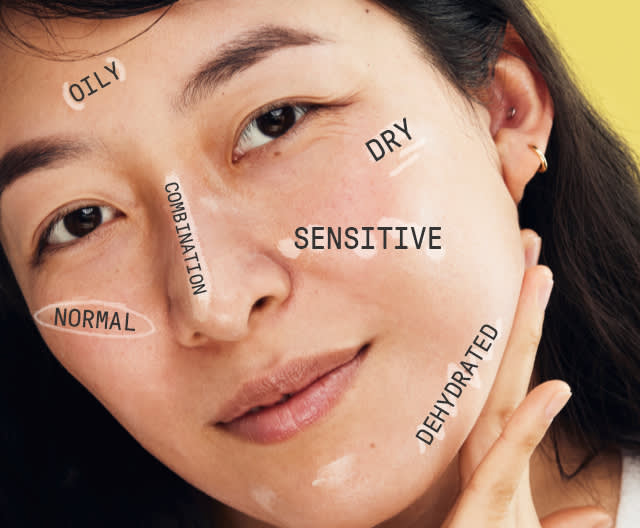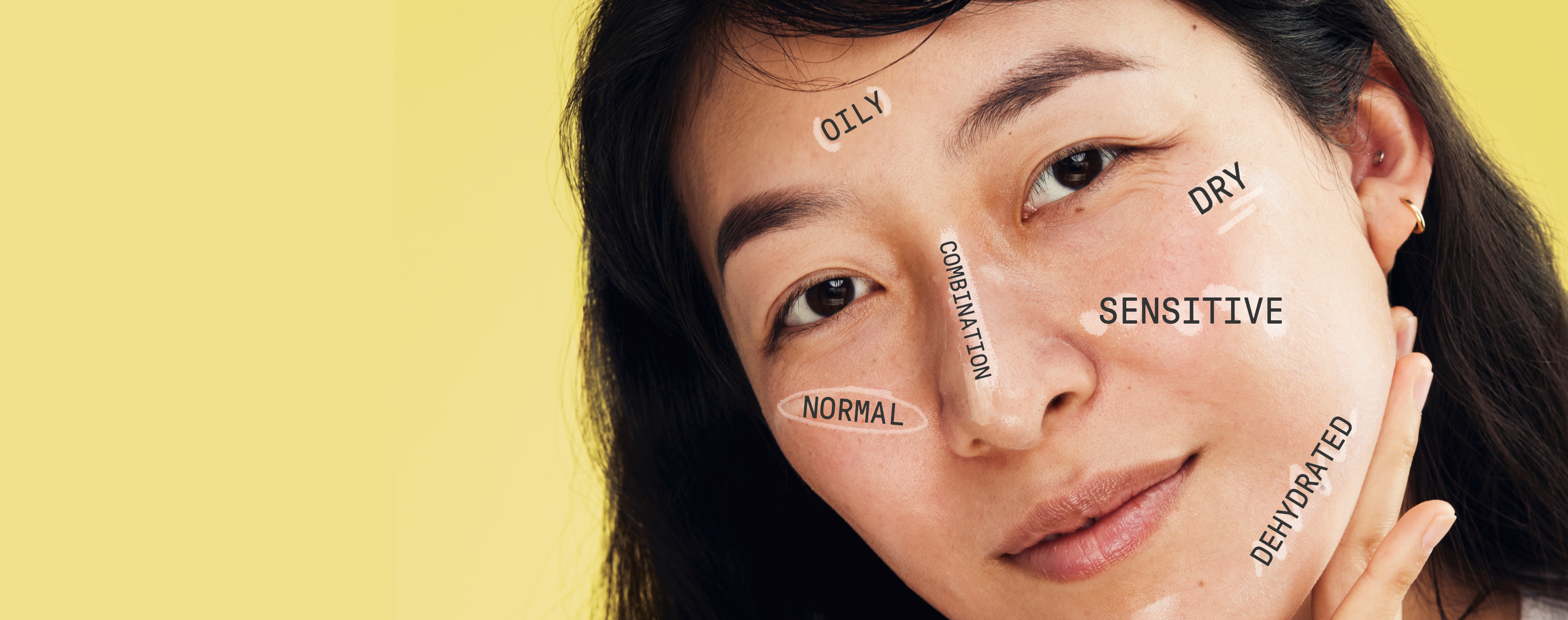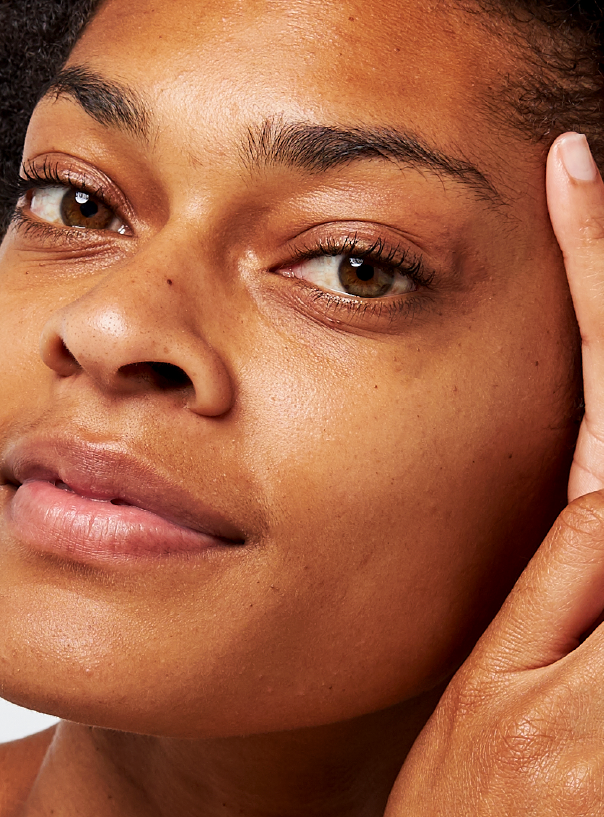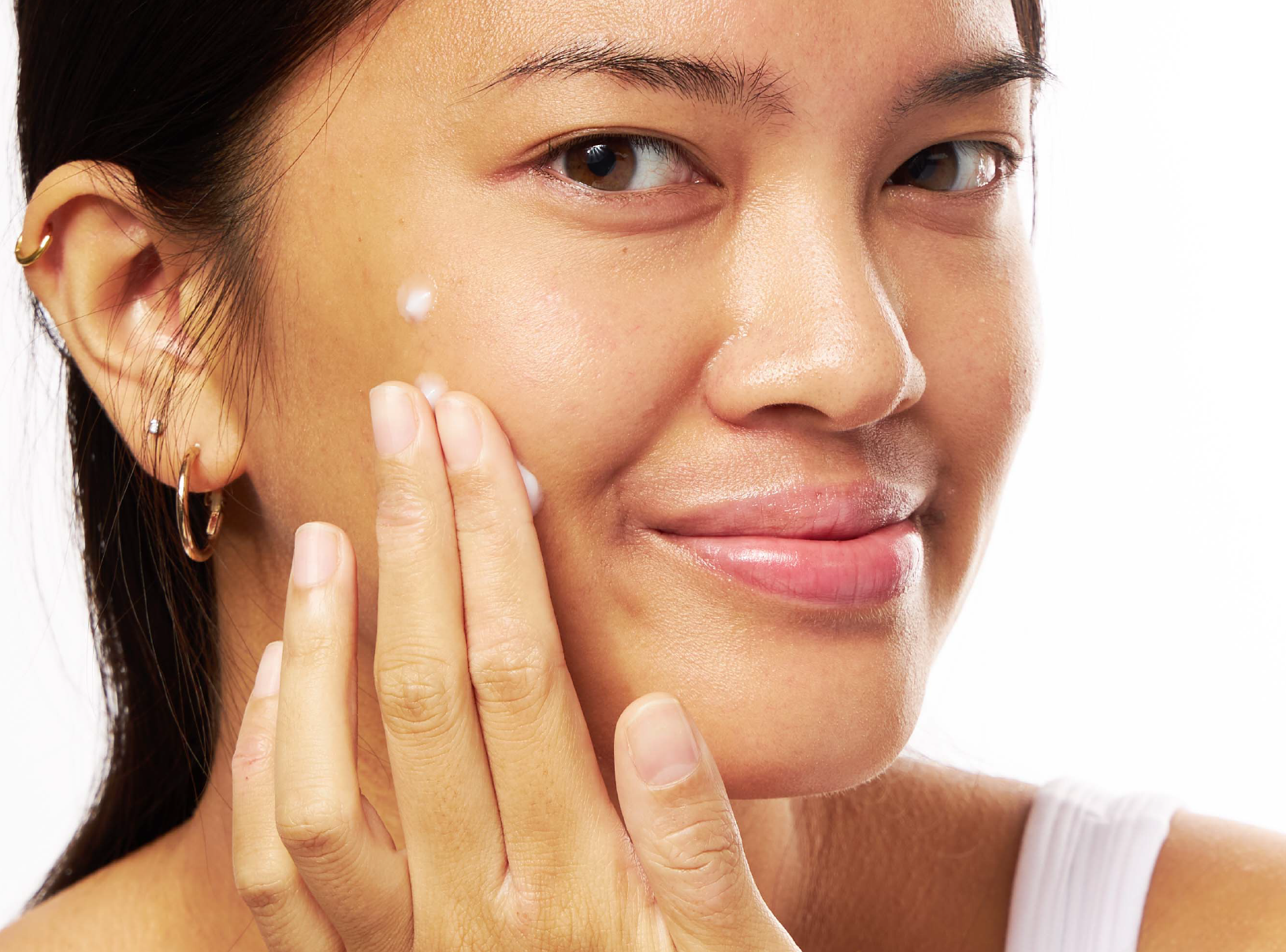Education
What is your skin type and how do you care for it?


SHARE
Education
What is your skin type and how do you care for it?
Medically reviewed by Kristin Hall, FNP
Written by Apostrophe Team
Last updated 11/1/2024
Everybody has a type — of skin, that is.
Your skin is as unique as you are, but there are certain characteristics you’re likely to notice in your skin and there are specific things you should do (and not do) to care for it.
Let’s take a closer look at the different skin types and how to care for them.
What Are the Different Skin Types?
Generally speaking, there are four different skin types, though some beauty experts throw in a fifth. The different skin types are as follows:
Normal
Dry
Oily
Combination
Sensitive
Now, let’s take a closer look at each of them.
Normal Skin
The condition of your skin may be what you consider normal but, by dermatological standards, normal skin is neither oily nor dry. It is generally well-balanced in terms of tone, texture, and pore size—it looks fairly healthy without any product on it.
If you have normal skin, you may still find that your skin becomes dry or oily from time to time but, for the most part, your skin is fairly healthy. The scientific classification of healthy skin is “eudermic.”
Your pores are small and your skin doesn’t have an excessive amount of shine. In terms of texture, it is neither flaky nor cracked, and you have a fairly even skin tone with few blemishes.
Dry Skin
This type of skin usually feels tight due to dehydration and there may also be patches of scales and flaking. Women with dry skin usually have invisible pores and they may have more visible fine lines and premature wrinkles.
In many cases, dry skin is hereditary, as genetics can affect the amount of sebum produced in the skin. Sebum is simply oil produced by the sebaceous glands which is responsible for keeping the skin supple and soft. Low sebum production can leave your skin feeling dry and tight.
Oily Skin
It is easy to identify oily skin because it usually has a high degree of shine. Oily skin is also more prone to frequent breakouts. Oily skin is the result of several factors including a hereditary predisposition to overactive oil glands as well as hormonal changes.
Sebum helps keep the skin moisturized and protected, but too much of it can lead to problems like acne breakouts.
Excessive sebum production is often linked to an increase in androgen production. Androgens are male hormones that trigger sebum production.
When excess oil is produced, the pores may expand and become blocked by oil, dirt, and dead skin cells which leads to breakouts.
Women with oily skin often have visible pores and they may have trouble keeping makeup on their skin all day long.
Combination Skin
As you can imagine, combination skin is a combination of dry and oily, often on different portions of the face.
Combination skin is the most common skin type, though it can sometimes be hard to identify.
In many women with combination skin, the T-zone is oily and shiny, while the cheeks may be dry. The T-zone includes the forehead, nose, mouth, and chin.
Sensitive Skin
Though sensitive skin is not a skin type in the same way that normal, oily, and dry skin are, there are certain characteristics that identify this skin type.
Sensitive skin often includes irritation, burning, or stinging after using different facial products.
You may also have some redness and inflammation. It is important to choose the right beauty products for your skin type and to use them correctly.
Beauty Do's and Don'ts
Now that you know more about the different skin types, which type of skin do you have? And how do you care for it properly?
The key to knowing how to properly care for your skin is understanding the cause of your skin problems in the first place.
Dry skin may be caused by not drinking enough liquids, living is a dry climate, spending too much time in the sun, or even losing sweat and oil glands which can be associated with the normal aging process.
Oily skin, on the other hand, is the result of overproduction of sebum which can be triggered by genetics and hormones.
Oily skin can also be dehydrated.
There are a variety of factors that influence your skin type and its condition. Everything from climate and pollution to the medications you take, your stress level, and hereditary factors influence your skin. Knowing your skin type is half the battle, but you also need to know how to (and how not to) care for your skin based on your skin type.
Here are some simple beauty Dos and Don’ts based on skin type:
Dry Skin (Do) – Do create a skincare routine that traps the oils you already have and adds more of the oil and moisture your skin needs. Use hydrating and skin-protecting products. When washing your face, let it absorb some of the moisture then apply your favorite moisturizer while the skin is still damp.
Dry Skin (Don’t) – Don’t use foaming cleansers, clay or charcoal masks, and skincare products that contain alcohol which could dry your skin out even more. Don’t use harsh exfoliating products that might strip your skin of its natural oils.
Oily Skin (Do) – Do create a skincare routine that focuses on moderating your sebum production and avoiding products that clog your pores. Look for light, water-based products and gentle acne treatments, if needed. If your face feels oily, use a blotting sheet rather than over-washing.
Oily Skin (Don’t) – Don’t use thick, oil-based cream moisturizers or heavy facial oils. Avoid using harsh scrubs and over-drying formulas like benzoyl peroxide as well as charcoal masks because they’ll strip the skin and cause it to produce more oil.
Combination Skin (Do) – Do create a custom skincare routine with different products for different parts of your face. Use moisturizing products in dry areas like the cheeks and jawline with sebum-reducing products on the T-zone to tackle shine.
Combination Skin (Don’t) – Don’t use harsh, foaming cleansers that will dry out your already dry areas like the chin and cheeks. Avoid using heavy moisturizers on the T-zone where excess oil may already be clogging your pores. Don’t use clay masks or oil-reducing formulas on dry areas.
Normal Skin (Do) – Do create a skincare routine that targets your problem areas with specific products. Know what your specific concerns are (like redness or wrinkles) and choose the best products to solve those problems.
Normal Skin (Don’t) – Don’t use harsh cleansers and scrubs that will damage your skin’s moisture barrier and lead to irritation and sebum production. Avoid drying products like highly concentrated acne treatments and DIY chemical peels.
As you can see, caring for your skin type is not difficult. You simply need to know what kind of skin you have and what to do (and not do) to keep it healthy. If you’re still not sure what type of skin you have, or if you’re dealing with serious skin problems, consult your dermatology practitioner or healthcare provider.
Buying the Best Products for Your Skin Type
Beauty products are a dime a dozen. Every brand has its own line and it may seem impossible to choose the right products. Now that you have a better understanding of your skin type and how to care for it, however, you’re on the right track.
So, how do you buy the best products for your skin type?
First, think of your goals. Refer back to the Dos from the previous section.
For dry skin, you want to add moisture and lock it in. For oily skin, you want to remove excess oil. For combination skin, you want to accomplish both of these goals on different parts of your face. For normal skin, you just want to keep things clean, clear, and healthy.
Here are some suggestions for what to look for when shopping for the best skin care products for your individual skin type:
Dry Skin – Look for gentle cream cleansers and thick moisturizing creams. Facial oils can be applied over your moisturizer at night to lock in moisture and products made with lactic acid will gently exfoliate dead skin cells over time, leaving your skin brighter and smoother without losing hydration. Look for ingredients like hyaluronic acid, glycerin, and aquaporins.
Oily Skin – Choose light, water-based serums and lightweight moisturizers. Apply the serum before moisturizing and use an all-over acne treatment like salicylic acid, when needed. To deal with excess oil throughout the day, use blotting sheets or mattifying powder.
Combination Skin – Stick with gentle, neutral formulas and spot-treat oily and dry areas with customized products. Use gentle cleansers all over your face with lightweight lotion for moisture. Use thicker moisturizers on dry spots and mattifying powder on oily areas.
Normal Skin – Look for neutral, gentle products that won’t make any of your minor skin concerns worse. Avoid harsh scrubs that could damage your skin or dry it. Choose products made with retinoids to address fine lines and wrinkles, glycolic acid for dullness and dark spots.
The key to keeping your skin clean and healthy is to choose the right products and use them properly. Don’t slather your face with heavy moisturizers or scrub the life out of it with exfoliants. The gentler you are with your face and with your skincare products, the better.
But what about acne-prone skin? How do you choose the best beauty products?
Any of the four skin types can be prone to acne, so treating it can be tricky. If you are prone to acne, you should still develop your skincare routine according to your skin type then add in some acne-fighting products that won’t destroy your results.
Here are some simple Dos and Don’ts for acne-prone skin:
Acne-Prone Skin (Do) – Do build your skincare routine according to your skin type then add acne-fighting products as needed. Use a salicylic acid toner as an all-over treatment under your moisturizer and spot-treat blemishes with benzoyl peroxide.
Acne-Prone Skin (Don’t) – Don’t use any harsh exfoliating products like scrubs or electric facial brushes because they’ll irritate or damage your skin barrier, causing more sebum production and more acne. Avoid using too many acne treatments at once and don’t pick or squeeze your blemishes.
Even if you feel like your skin is healthy, there are probably simple changes you can make to your skincare routine to tackle issues such as dryness, shine, uneven tone, and acne.
Knowing your skin type and building a daily skincare routine around it is the best way to keep your skin hydrated, supple, and smooth. If you’re using the wrong products, you could actually be making matters worse, and that is the last thing any woman wants.
So, take what you’ve learned here and take a closer look at your skincare arsenal to see if there might be room for improvement. Best of luck!
Like what you just read? Sign up for our email list to get the scoop on skincare science delivered straight to your inbox.

Deep Dives
A dermatologist shares his thoughts on the recent studies about benzoyl peroxide and benzene.
Read More
Education
What is milia?
What is milia? Today, we’re jumping into one type of bump that you may have heard about most commonly in infants — milia.
Read More
Education
Best moisturizer for acne-prone skin
If you have combination acne-prone skin, figuring out which moisturizer is best for your skin might be tough. In this guide, we break down the best moisturizer for combination, acne-prone skin.
Read More

